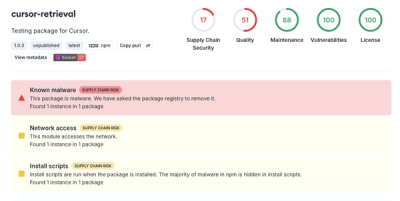
Security News
The Risks of Misguided Research in Supply Chain Security
Snyk's use of malicious npm packages for research raises ethical concerns, highlighting risks in public deployment, data exfiltration, and unauthorized testing.
@commercetools-uikit/tooltip
Advanced tools
Tooltips display informative text when users hover over or focus on an element.
Tooltips display informative text when users hover over or focus on an element.
yarn add @commercetools-uikit/tooltip
npm --save install @commercetools-uikit/tooltip
Additionally install the peer dependencies (if not present)
yarn add react
npm --save install react
import { forwardRef } from 'react';
import PropTypes from 'prop-types';
import ReactDOM from 'react-dom';
import styled from '@emotion/styled';
import Tooltip from '@commercetools-uikit/tooltip';
/* 1. Standard example */
const ExampleStandard = () => (
<Tooltip
placement="left"
title="If you buy a pizza, you will also get a free ice cream :)"
>
<button onClick={() => {}}>Submit</button>
</Tooltip>
);
/**
* 2. Working with disabled child elements
*
* When you use a tooltip with a disabled element, you should define the
* style `pointer-events: none` to the disabled element to stop it from capturing events.
* The Button components from UIKit already support this functionality.
*/
const ExampleWithDisabledElements = () => (
<Tooltip
placement="left"
title="You do not have permission to delete the database"
>
<button disabled onClick={() => {}} style={{ pointerEvents: 'none' }}>
Delete production database
</button>
</Tooltip>
);
/**
* 3. Customizing the wrapper
*
* The tooltip applies event listeners (`onMouseOver`, `onMouseLeave`, `onFocus`,
* and `onBlur`) to a wrapping `div` component around the children element.
* By default, this wrapper is displayed with style `inline-block`.
* If you want to customize this behaviour, then you can pass in a custom element.
* Be sure to use `React.forwardRef`, as we need the to pass the ref to the wrapper.
*/
const Wrapper = forwardRef((props, ref) => (
<div ref={ref} style={{ display: 'block' }} {...props}>
{props.children}
</div>
));
Wrapper.propTypes = {
children: PropTypes.node.isRequired,
};
const FullWidthButton = styled.button`
display: block;
width: 100%;
`;
const ExampleWithCustomWrapper = () => (
<Tooltip title="Delete" components={{ WrapperComponent: Wrapper }}>
<FullWidthButton>Submit</FullWidthButton>
</Tooltip>
);
/**
* 4. Customizing the tooltip body
*
* You can customize the look and feel of the tooltip body by passing in a custom `BodyComponent`.
*/
const Body = styled.div`
color: red;
`;
const ExampleWithCustomBody = () => (
<Tooltip title="Delete" components={{ BodyComponent: Body }}>
<button>Submit</button>
</Tooltip>
);
/**
* 5. Customizing where the portal is rendered
*
* When you are dealing with virtualized components, it can be useful to render
* the tooltip into another part of the document.
* You can define a `TooltipWrapperComponent` to do this.
*/
const Portal = (props) => ReactDOM.createPortal(props.children, document.body);
const ExampleWithCustomPortal = () => (
<Tooltip title="Delete" components={{ TooltipWrapperComponent: Portal }}>
<button>Submit</button>
</Tooltip>
);
/**
* 6. Conditionally displaying tooltips
*
* There may be cases when you only want to enable the display of a tooltip under
* a certain condition. In these cases, you may want to use the `off` prop.
* In the following example, the tooltip text only appears on hover when the button is disabled.
*/
const ExampleWithConditionals = (props) => (
<Tooltip
off={props.isDisabled}
title="You do not have permission to perform this action"
>
<button disabled={props.isDisabled}>Submit</button>
</Tooltip>
);
ExampleWithConditionals.propTypes = {
isDisabled: PropTypes.bool,
};
/**
* 7. Fine-tuning underlying Popper.js behavior
*
* This component uses [Popper.js](https://popper.js.org/) under the hood.
* Popper provides a way to adjust how tooltip element should behave, by providing
* a [set of `modifiers`](https://popper.js.org/popper-documentation.html#modifiers).
* For instance, forcing tooltip to stay in the original placement and not to try
* flipping when it's getting out of boundaries, can be implemented as following:
*/
const ExampleWithCustomPopperBehavior = (props) => (
<Tooltip
placement="left"
title="I will always be on the left side"
modifiers={{
preventOverflow: {
enabled: false,
},
flip: {
enabled: false,
},
}}
>
<button disabled={props.isDisabled}>Submit</button>
</Tooltip>
);
ExampleWithCustomPopperBehavior.propTypes = {
isDisabled: PropTypes.bool,
};
export {
ExampleStandard,
ExampleWithDisabledElements,
ExampleWithCustomWrapper,
ExampleWithCustomBody,
ExampleWithCustomPortal,
ExampleWithConditionals,
ExampleWithCustomPopperBehavior,
};
| Props | Type | Required | Default | Description |
|---|---|---|---|---|
children | ReactElement | ✅ | ||
showAfter | number | 300 | Delay (in milliseconds) between the start of the user interaction, and showing the tooltip. | |
closeAfter | number | 200 | Delay (in milliseconds) between the end of the user interaction, and the closing of the tooltip. | |
styles | Record | Custom css-in-js object styles for the tooltip body. | ||
off | boolean | false | Determines if the tooltip should not appear. | |
id | string | An identifier for the tooltip, used for aria-describedby. | ||
onClose | FunctionSee signature. | A callback function, called when the tooltip is closing. | ||
onOpen | FunctionSee signature. | A callback function, called when the tooltip is opening. | ||
isOpen | boolean | |||
placement | unionPossible values: , 'top', 'top-start', 'top-end', 'right', 'right-start', 'right-end', 'bottom', 'bottom-start', 'bottom-end', 'left', 'left-start', 'left-end' | 'top' | How the tooltip is positioned relative to the child element. | |
title | string | ✅ | The message to show in the tooltip. | |
modifiers | Modifiers | Provides a way to fine-tune an appearance of underlying Popper tooltip element. For more information, please check Popper.js documentation. | ||
components | ObjectSee signature. | Customize the appearance of certain elements of the tooltip. | ||
horizontalConstraint | unionPossible values: , 1, 2, 3, 4, 5, 6, 7, 8, 9, 10, 11, 12, 13, 14, 15, 16, 'scale', 'auto' | 'scale' | Horizontal size limit of the tooltip. |
onClose(e?: ChangeEvent | FocusEvent) => void
onOpen(e?: ChangeEvent | FocusEvent) => void
components{
/**
* The component rendered as the tooltip body.
*/
BodyComponent?: ComponentType;
/**
* Where the tooltip should be rendered. This can be useful to render the tooltip into another part of the document, using React portal.
*/
TooltipWrapperComponent?: ComponentType;
/**
* A custom component wrapper for the tooltip.
*/
WrapperComponent?: ComponentType;
}
FAQs
Tooltips display informative text when users hover over or focus on an element.
The npm package @commercetools-uikit/tooltip receives a total of 5,965 weekly downloads. As such, @commercetools-uikit/tooltip popularity was classified as popular.
We found that @commercetools-uikit/tooltip demonstrated a healthy version release cadence and project activity because the last version was released less than a year ago. It has 0 open source maintainers collaborating on the project.
Did you know?

Socket for GitHub automatically highlights issues in each pull request and monitors the health of all your open source dependencies. Discover the contents of your packages and block harmful activity before you install or update your dependencies.

Security News
Snyk's use of malicious npm packages for research raises ethical concerns, highlighting risks in public deployment, data exfiltration, and unauthorized testing.

Research
Security News
Socket researchers found several malicious npm packages typosquatting Chalk and Chokidar, targeting Node.js developers with kill switches and data theft.

Security News
pnpm 10 blocks lifecycle scripts by default to improve security, addressing supply chain attack risks but sparking debate over compatibility and workflow changes.